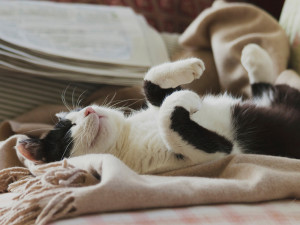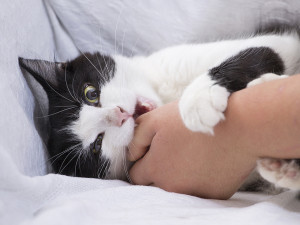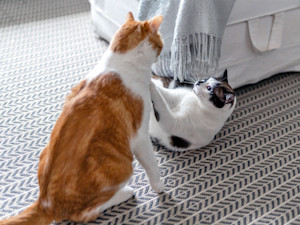Why Do Cats Roll on Their Back?
Maybe they just want to scratch that itch...

Share Article
In This Article:
Most Common Reasons Why Cats Roll on Their Back How to Respond to a Cat Rolling on Their Back Do You Need to See a Vet if Your Cat Is Rolling Around a Lot?
You’ve probably seen your cat belly-up, legs stretched out long, squirming around like a wiggly worm on the floor. What is this insanely cute thing, and why is it happening?
Is this odd behavior trying to tell you something vitally important about your cat’s purpose in the world, or are they just scratching an itch? We’re talking about cats — one of the world’s most confusing creatures. So, the answer is probably both, neither, and everything in between.
Let’s look at some of the reasons your cat likes to roll on their back.
How much do you spend on your pet per year?

Most common reasons why cats roll on their back
Cats have reasons for everything they do. Some are simple and straightforward. Others are complex and hard to decipher. When it comes to rolling on their backs, it’s a little of both.
It’s fun for them.
As I said, some are really simple. If your cat enjoys rolling around, they’re likely to do it often. It’s silly. And if you’re anything like me, you react with something big like announcing, “You are the cutest cat who ever lived in the history of the entire universe, and I want to snuggle you until my head explodes!” when you see it, which makes it more exciting for your cat. They’re just having a good time.
It feels good or is comforting.
I can imagine rolling and wiggling on their backs would feel quite good. It’s a back scratcher and mini massage all in one. (Now I want to try it myself.)
It’s also one way that your cat can leave their scent. Cats have scent glands in various spots on their body. Wherever they roll, they deposit scent and pheromones, which can be soothing if they’re feeling a bit anxious.
They are seeking attention.
It takes incredible willpower to resist an exposed kitty belly. Whether you show your enthusiasm verbally (for cats who don’t love their bellies rubbed) or you tuck and roll to get to your cat as quickly as possible so you can dive into that belly (for cats who love a belly rub), it’s all attention. Cats learn quickly what gets a reaction from us when they want one. For me, rolling on the ground with that belly out always gets a positive response.
They are regulating their temperature.
Your cat will instinctively seek out surfaces that help maintain their ideal temperature. If it’s warm outside, they may roll on cool surfaces, like a tile floor or stone countertop. On cold days, they may roll in front of the fireplace or heating vent. They’re simply exposing their bodies to that temperature by rolling on their backs.
This is mating behavior.
A female cat in heat (meaning she’s ready to mate) will do a lot of rolling around. Her system is flooded with hormones that trigger behaviors like rolling and vocalizing. She’s spreading her scent and pheromones to communicate with male cats in the area and letting loose as instinct takes over during this intense time.
They are being territorial.
We know that rolling on their back deposits scent and pheromones. That means it’s useful behavior for marking territory. Scent is just one way cats communicate with each other — not only where they are now, but where they’ve been and how recently they were there. The strength of a cat’s scent in an area gives visiting cats a clue as to whether the original cat is still around, in which case they may want to keep their distance.
They are trying to relieve health symptoms.
Your cat may roll on their back if they’re experiencing itching skin or physical discomfort, similar to the way they often lick or over-groom areas of discomfort. You may see cats with allergies rolling on their backs to control itching. An uncomfortable cat may roll trying to find a more comfortable position to rest in.
Think about how you’re unsettled and squirmy if you don’t feel good, your back hurts, you have a stomach ache, etc. Your cat may have the same instinct. How can you tell the difference between rolling for positive reasons and rolling for health issues? Don’t worry. We’ve got that info coming up.
How to respond to a cat rolling on their back
Your cat rolling on their back is an instinctual behavior. They’ve got lots of good reasons to do it. It’s perfectly natural.
Your instinctual reaction to seeing a cat rolling on their back may be to squeal deligthfully and dive face-first into that belly. While it sounds like a good idea, show some restraint, especially if you don’t know this cat extremely well.
Exposing their belly is a risky position for a cat because that’s a sensitive area that can be seriously damaged in an attack. On the other hand, belly-up is a good defensive position because all four paws and their attached razor blade claws are pointing up. This means a cat rolling on their belly could be totally relaxed and ready for a belly rub, on alert because they’re exposing a sensitive area, or ready to put those claws to use if they feel threatened. Talk about mixed signals, right?
If you know your cat well, they’re doing the usual belly-up behavior, and they like to be petted in this position, go for it. But be gentle and watch body language closely. If your cat starts turning away from you, swishing their tail more intensely, turning their ears, getting giant pupils, or really anything other than staying loose and relaxed, take a break. They may be overstimulated, crossing the line from accepting the petting to being defensive and wanting you to stop.
For cats you don’t know extremely well, it’s better to appreciate the belly from a distance. If you do want to try petting this cat, don’t go straight for the belly. That’s not the way to introduce yourself. Start with a few pets on the head, if the cat seems open to it, and see how that goes. And watch that body language!
Do you need to see a vet if your cat is rolling around a lot?
It can be hard to tell whether your cat rolling on their back is normal behavior or a sign that something is wrong. Here are three helpful questions to ask yourself:
Is this a new behavior? If your cat has always rolled like crazy, and they’re simply continuing that behavior, it’s probably not a medical issue. On the other hand, if they’re suddenly rolling in a way they never have before, and especially if you’ve noticed other changes in their normal behavior (eating habits, play, interest in affection, energy levels, etc.), it’s time to call your vet.
Do they seem obsessed with rolling? If it’s difficult to interrupt your cat’s rolling, there could be a medical problem. In this case, you may see them rolling, and when you try tossing their favorite toy, calling their name, picking them up, etc., they either ignore you or stop for a moment and then go right back to rolling. The rolling seems more important than anything else because they’re doing it to relieve discomfort. Again, call your vet.
Do they seem stressed while rolling? There’s a difference between carefree, silly flopping around that your cat is clearly enjoying and intense rolling where your cat may be vocal, have their ears back, seem anxious, or show other signs of stress. This is probably rolling due to physical discomfort.
It can be really helpful to take video of your cat’s rolling behavior to show your veterinarian. They can look for signs of pain, notice if your cat is focusing on a specific part of the body, or catch something “off” about the way your cat is moving.
Bottom line
Rolling on their backs is a fun, healthy behavior that just about every cat does.
Don’t assume that a cat rolling on their back is asking for a belly rub. Some cats find belly rubs very stressful and intrusive.
Rolling that seems obsessive or changes dramatically from your cat’s normal rolling behavior could be a sign of pain or discomfort. Give your vet a call.
References
“Reading Your Cat’s Body Language.” Oregon State University. Accessed August 7, 2025. https://indoorpet.osu.edu/sites/default/files/assets/documents/hospital/indoorcat/Reading%20Cat%20Body%20Language.pdfopens in new tab.

LeeAnna Buis, CFTBS, FFCP
LeeAnna Buis has adored cats her entire life and thought she knew them inside out and sideways. But it wasn’t until she worked with a feline behavior consultant that she fully understood how incredible, complicated, and inspiring they really are. She made a career change, starting the certification process to become a behavior consultant right away. She discovered what unique, fascinating, complex creatures cats are and knew this was what she wanted to do with her life — help others on a similar journey to truly knowing, loving, and appreciating their cats.
LeeAnna earned her certification through Animal Behavior Institute, where she received the certified feline training and behavior specialist (CFTBS) designation.
Related articles
![]()
How to Read Your Cat’s Poker Face
A guide to their not-so-secret tells.
![Black and White cat with its eyes closed laying on its back on a scarf]()
Is My Cat Happy?
In this excerpt from her new book, Purr: The Science of Making Your Cat Happy, animal behaviorist Zazie Todd shares science-backed insights into our cats’ moods.
Why Does My Cat’s Tail Vibrate?
They’re trying to tell you something... but what?
![cat biting person's hand]()
Why Does My Cat Bite Me?
Don’t live in fear of your feline overlord.
![Man holding his large orange cat in his arms.]()
How to Reinforce the Bond With Your Cat
A behaviorist’s advice.
![Two cats fighting at home.]()
Recognizing Red Flags: Essential Warning Signs When Introducing Cats
And how to avoid any problems.







